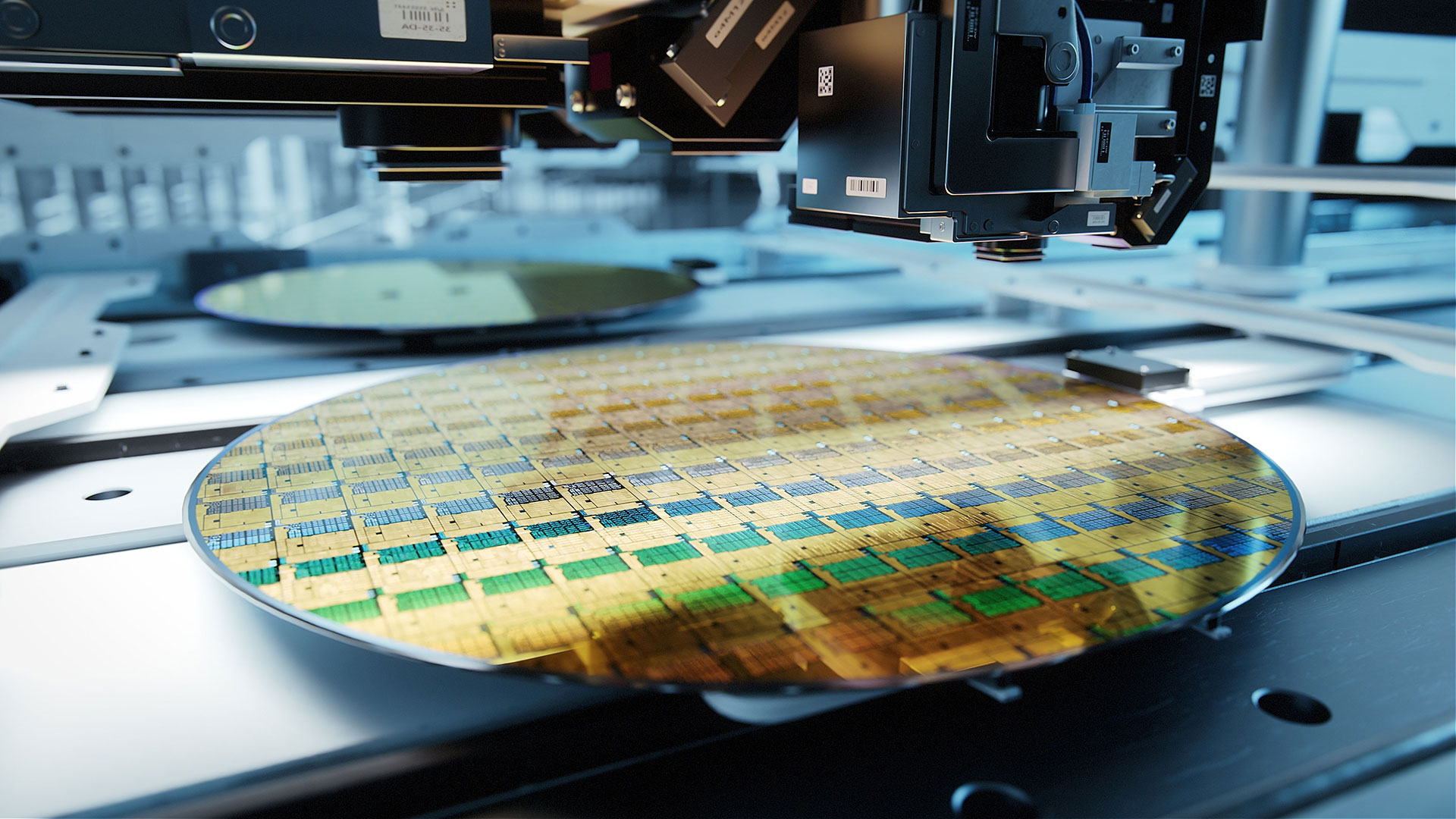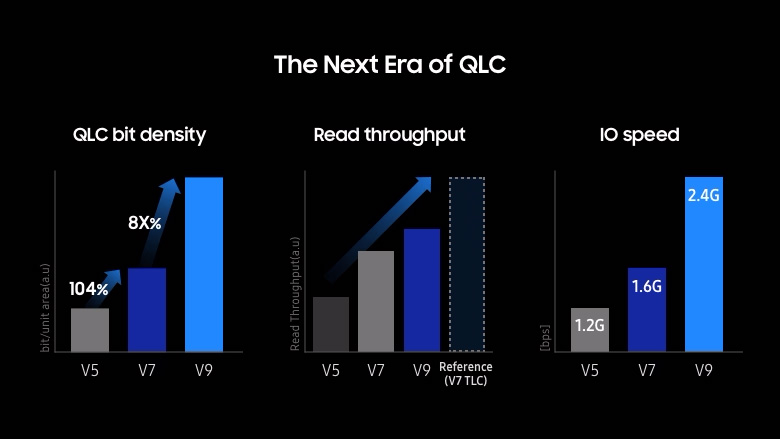Samsung's upcoming 280-layer QLC flash could allow for 16TB M.2 SSDs — claims up to 50% higher storage density than the competition
Samsung is gunning for the storage density crown for 2024.

ComputerBase reports that Samsung is preparing to announce its next-generation QLC NAND V9 flash solution, bolstering a seriously impressive density size of 28.5Gb/mm^2. Samsung's new QLC flash is substantially denser than its competitors (QLC and TLC) making it it as the most dense flash solution so far by a long shot.
| Row 0 - Cell 0 | Micron | Samsung | WD/Kioxia | SK hynix | YMTC |
| Shipping Now | 232-Layer QLC | 280-Layer QLC | 162-Layer QLC | 176-Layer QLC | 232-Layer QLC |
| Density per square mm | 19.5 Gb mm^2 | 28.5 Gb mm^2 | 13.86 Gb mm^2 | 14.40 Gb mm^2 | 20.62 Gb mm^2 |
| Die Capacity | 1 Tb | 1 Tb | 1 Tb | 512 Gb | N/A |
| Next-Gen (release date) | ? | Projected 2024 | 212-Layer (unknown) | 238-Layer (2024) | Unknown |
At 28.5Gb/mm^2, Samsung's new QLC 3D NAND V9 solution is nearly 50% denser than YMTC's 232L QLC NAND flash at 20.63mm^2, which used to be the industry's densest flash. YMTC is currently just ahead of Micron's 232-layer TLC, which comes in at 19.5 Gb/mm^2.
V9 won't be slow either: Samsung's V9 QLC reportedly has a maximum transfer rate of 3.2 Gbps. That's substantially faster than outgoing QLC-based products that offer only 2.4 Gbps. Speed has been an underlying problem with QLC in the past, and Samsung's new V9 NAND flash indicates it has made strides to rectify the issue. At 3.2 Gbps (per chip), V9 should be more than adequate for use in PCIe SSDs. How it performs in practice of course remains to be seen.
What's not clear is how performance will scale when writing directly in QLC mode. All current QLC SSDs use a pSLC cache that's up to 25% of the total available capacity, where performance is substantially higher. Depending on the NAND, we typically see write speeds drop to 100~300 MB/s once the cache is full.
If performance is good enough, Samsung's new QLC-based flash could radically change the consumer SSD landscape when it arrives later this year. QLC still likely won't be able to service high-performance SSDs, such as those bolstering PCIe 5.0 transfer speeds, but it should be well suited to lower tier PCIe drives. With a near 50% lead in storage density, we can expect any new Samsung drives featuring its new V9 QLC flash to provide competitive value, potentially featuring the best price per gigabyte in the industry.
Depending on market demand, Samsung could also potentially even offer a V9 QLC M.2 drive with more than 8TB of capacity, which is the highest capacity of any consumer-based M.2 drive right now. It's possible Samsung might even be able to do a single-sided 8TB drive.

According to a Samsung report from 2022, Samsung is basically going all in on QLC development. With TLC flash architectures beginning to reach their limits in terms of raw storage capacity (just like SLC and MLC before it), QLC represents the future for SSD manufacturers that want to keep pushing the capacity envelop of mainstream-consumer SSDs. It could even find it's way into enterprise SSDs down the road. V9 is just the next step in Samsung's QLC roadmap. Future generations should be even faster than V9, and could eventually compete directly with today's outgoing TLC flash architectures in raw performance.
Get Tom's Hardware's best news and in-depth reviews, straight to your inbox.

Aaron Klotz is a contributing writer for Tom’s Hardware, covering news related to computer hardware such as CPUs, and graphics cards.
-
Amdlova Nice :] 16tb of storage... slow as <Mod Edit> when need it and 3000tb of endurance. Can't waitReply -
usertests ReplyAt 28.5Gb/mm^2, Samsung's new QLC 3D NAND V9 solution is nearly 50% denser than YMTC's 232L QLC NAND flash at 20.63mm^2
It's about 38.15% denser, what I'd call nearly 40%.
With TLC flash architectures beginning to reach their limits in terms of raw storage capacity (just like SLC and MLC before it), QLC represents the future for SSD manufacturers that want to keep pushing the capacity envelop of mainstream-consumer SSDs.
TLC is always 75% of QLC. There's no limit to reach, other than the endurance limit. -
Alvar "Miles" Udell ReplyIf performance is good enough, Samsung's new QLC-based flash could radically change the consumer SSD landscape when it arrives later this year.
Considering all manufacturers are slashing production to drive up prices, I don't see anything changing "radically". I don't even see Samsung pricing these at $199.99/4TB $599.99/8TB -
Notton I'm confused. In the "NAND Capacities and Densities" chart you have, why is 1Tb tied between Micron, Samsung, and WD? Is that chart correct?Reply
The SN570 2TB, for instance, only uses a single 2TB chip.
Are they all 1Tb densities, and then stacked into a single package to form 2TB and 4TB chips?
Or They're all 1Tb, forming 2TB chips, but the Samsung takes up the least surface area? -
Li Ken-un 8 TB M.2 SSDs have clung to sky high prices. 16 TB ones are incoming… but NAND prices are also skyrocketing. Who else is thinking of the same thing as I: playing the waiting game? 🙂Reply -
vern72 No way in hell I'm ever getting QLC storage. I'm still ticked off at the term "3-bit MLC". That's TLC!Reply -
whatever66 To the author:Reply
bolstering
I do not think that word means what you think it means. Try "boasting". -
Flayed Reply
They write so slowly will take forever to reach the endurance limit though :Ppug_s said:I think I till try to avoid qlc ssd because it has less endurance compared to tlc's. -
gg83 Is there a solid way to compare storage density between the new toshiba 30tb hdd vs this new Samsung ssd tech? It seems hdd's use a different density metric than nand?Reply